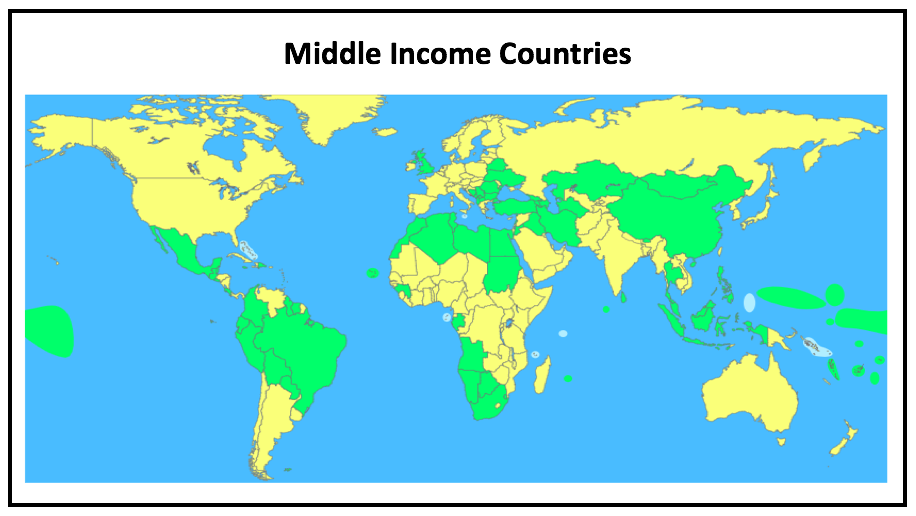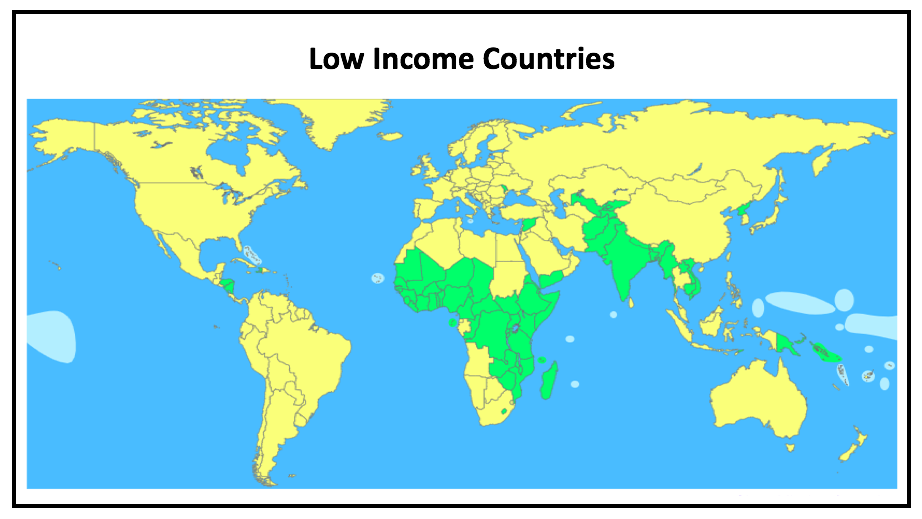Social scientists delineate the countries of the world in terms of income: high income, middle income, and low income countries. Countries are now classified this way, since the Berlin Wall fell in 1989 and ended the Cold War.
GDP is an economic term that stands for Gross Domestic Product, which is basically a way to measure the amount of output the economy is producing. ‘Output’ and ‘income’ are synonymous in economic terminology, therefore this measures the amount of income that a country has. When you divide the amount of income that the country has by the number of people in that country, you arrive at the gross domestic product per person, or per capita.
High income, mid income, and low income countries use this measure, and it's much better for today's society because it allows countries to move.
EXAMPLE
If a country got more income per capita and the economy could expand, it could become a high income country. Chile, for example, is now a high income country, but in the Cold War model, it was a third world country. In the Cold War model, the categories tended to be more fixed.What defines a high income country, middle income country, and a low income country?
For starters, high income countries have an average GDP per capita of over $12,000.
This is actually on the low end -- countries can be much higher than that. The United States, for instance, has an average per capita income of $45,000, which is quite higher than $12,000. However, $12,000 is the threshold to be considered relatively well-off relative to the other countries in the world.
When you think about it, the world is dramatically unequal. High income countries are what is commonly called the "Global North," consisting of European countries in Western Europe--Spain, Portugal, France, Germany, Great Britain, Norway, Sweden, and Denmark. It also includes America, Canada, and Russia.

You'll notice that if you were to look at all these countries on the globe, they would be in the Northern part of the globe, which is where most of the world's wealth is concentrated--hence the expression, the "Global North." There are some high income countries in South America, such as Argentina and Chile. Saudi Arabia, Australia, and New Zealand are also high income countries.
These countries were the first to industrialize, the first to develop industrial capitalism, the reason why being a hotly debated topic.
Regardless, being the first to industrialize unquestionably gave them a head start. When industrial production increased productivity, it gave the countries the economic might to bully other countries around, like colonial power and colonial expansion. These are the countries that currently have unanimous computer technology, and industrial production is widespread, so they can control the global economy.
EXAMPLE
The price of Peruvian coffee--Peru not being a high income country--is largely determined by the market vicissitudes of high income countries. High income countries are able to hold on to their power because they can bully other countries around and control the global economy.Middle income countries have an average GDP per capita--annual income--between $2,500 and $12,000.
About 57% of humanity actually lives in these countries, a percentage that is driven in large part by China, which is a middle income country. China is on the rise and is likely to advance into the high income country category within the 21st century, but right now it is still a middle income country, along with many former Soviet countries like Kazakhstan, Belarus, Ukraine, and Mongolia. Many countries in South America--Brazil, Colombia, Peru--are also middle income countries.

Slightly over half of the people within each middle income country live in cities. The remainder--just under half--live in rural areas. These countries’ industrial jobs are in the cities, but a lot of people still farm for a living out in the country. Critically, internet access and advanced computational and information processing technologies are not as readily available in middle income countries.
Low income countries account for 20% of the world's people, who make less than $2,500 annually.
These countries are primarily concentrated in Africa, but there are some in Southeast Asia, like Myanmar (formerly Burma) and in the Middle East, such as Afghanistan and Pakistan.

Low income countries are primarily rural and agrarian--their economies are not concentrated in cities and there's not a lot of industrial production. The people are more traditionally rural dwellers, using rural cultivation methods. They have problems with population density and disease, problems that have been largely eradicated in high income countries. However, because of the lack of income to combat them, these countries have these problems and suffer greatly because of them.
IN CONTEXT
Suppose a child from a prosperous American family sees a commercial asking for money to donate to help children in a poor country. The commercial shows these children struggling to get to school over a dangerous footbridge.
The American child might ask, innocently, “Why don't they just drive to school?” In the American child’s frame of reference, it’s difficult to relate to children in a poor country, who don’t have access to the same things. This illustrates the level at which Americans--and their children--living in a high income country, take their lives for granted.
Source: This work is adapted from Sophia author Zach Lamb.